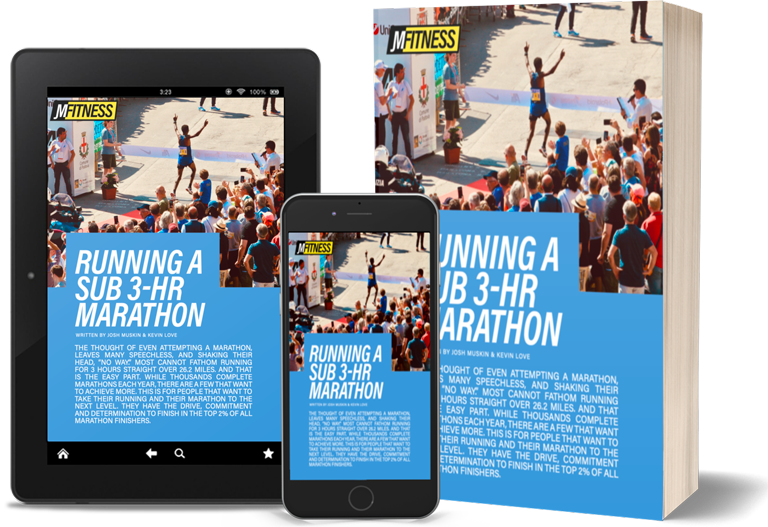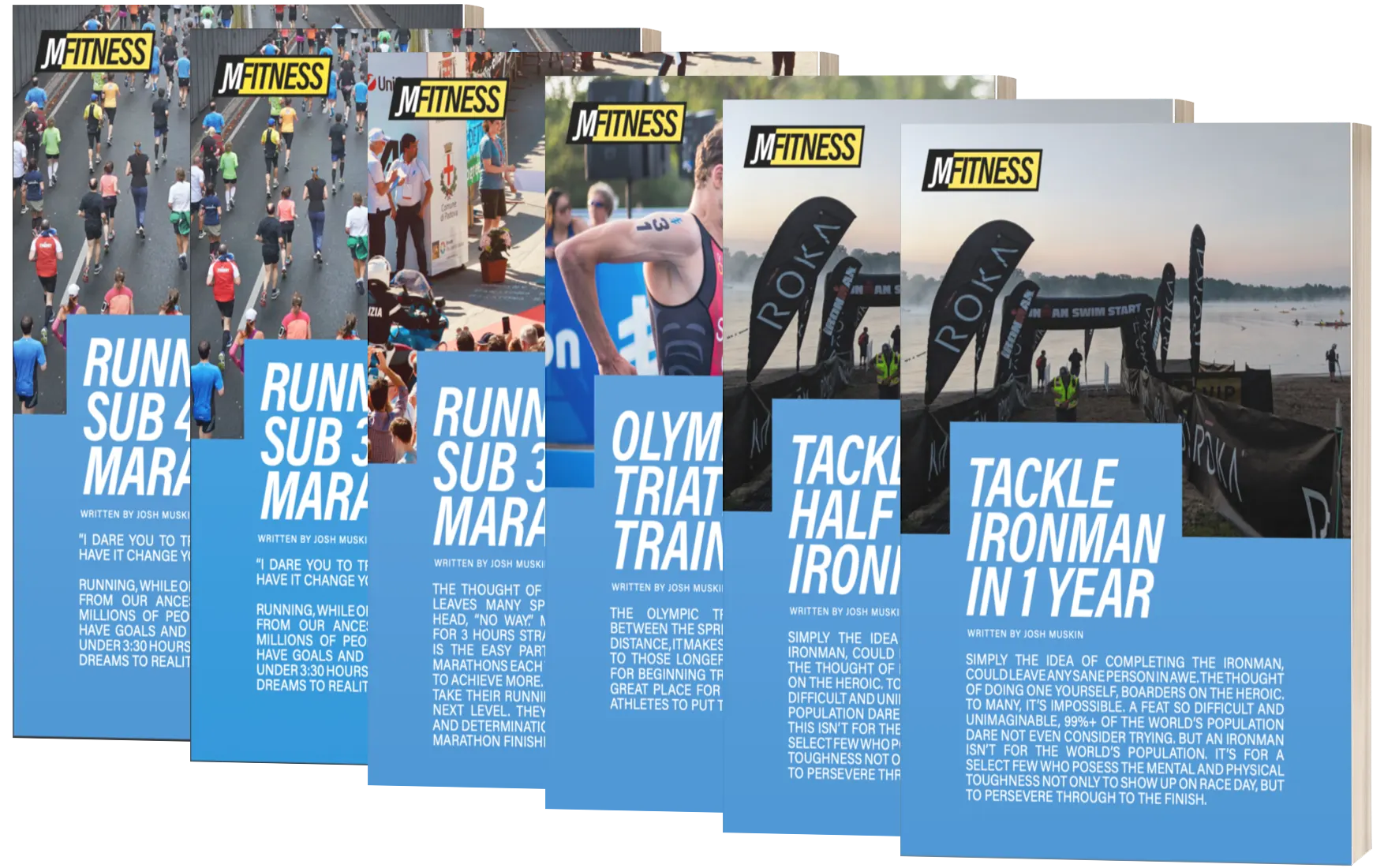Forget the Sub-2 hour marathon that Eliud Kipchoge ran – that’s just crazy talk. We’re here to talk about what it takes, and what’s entailed in a sub 3 hour marathon training plan.
The short version is, it involves a lot of running.
In reality, it involves much more than just pounding pavement for months on end.
Let’s be clear – this sub 3 hour marathon training plan is not of the “couch to marathon” variety. You’ll need to have a solid base before diving into this plan; more on that below.
Note: looking for a different time goal? Check out all of the marathon training plans available and find the one best suited for you.
To run a marathon in 3 hours, you need to maintain a 6:50 pace for 26.2 miles.
This also means you should be able to run faster than that pace for shorter distances. Consider these as guidelines:
This is some body text.
This training plan is also 16-18 weeks long, so it’s important to be able to run 30-40 miles per week out of the gate (week 1 is 40.5 miles over 6 sessions).
The first 14 weeks of your sub 3 hour marathon training mileage will follow the pattern of 2 week increased in mileage, followed by a 1 week decrease in mileage.
This is intentional to help your body absorb all the work it puts in during those 14 day cycles by allowing you to relax on the 3rd week.
The exception to this are the last 4 weeks which consist of 2 peak weeks (20 mile runs on 2 separate weekends) and then the taper (reduction in mileage/intensity) as you approach race day.
This helps you feel fresh and ready to go when you toe that start line, despite all the work you’ve put in up to this point.
Your sub 3 hour marathon training plan is measured in weeks, and each week follows a similar pattern:
Here you get a full on rest day after your long runs to help your body absorb the full week of training, and easy runs spaced between your harder ‘workout’ days.
With this format, its important to paraphrase a quote from elite marathoner Tommy ‘Rivs’ Puzey:
“Most people don't run the easy runs easy enough, or the hard runs hard enough. They spend too much time in between and burn themselves out”
You’re going to need to rest on those easy days. Yes you’ll be getting the miles in, but don’t worry if you’re not on the low end of the pace block for those runs. It’s important simply to safely get through the mileage, and then really push the workout runs hard.
You’re going to have to eat.
A lot.
But let’s define what you ‘should’ eat after this disclaimer:everyone is different modify this to fit your body these are just general guidelines.
In short, eat real food.
Meats & vegetables, nuts & seeds, some fruit, little starch, no sugar where you can help it.
Real food has an expiration date, and usually is found on the ‘outside’ of the grocery store. Your middle aisle trips should be reserved for spices & oils, not much else.
Processed foods and sugar will give you no benefit. In fact, they’ll likely slow you down and when you’re trying to run fast, for a long period of time, it’s quite literally the opposite of what you want.
It won’t be uncommon to burn hundreds, maybe even thousands of calories in a day depending on where you are in your training.
In order to remain healthy and avoid injury, none the less be properly fueled to handle the harder workouts, you’ll need to intake quite a lot of food.
Most people don’t pay that much attention to what they eat, especially at the macro level. Use something like MyFitnessPal to meticulously track your food intake for a few weeks. Get a sense of where your macros stand (protein vs carb vs fat) and learn to adjust. You’ll also gain a sense of how many calories you’re taking in and if you’re using something like a Garmin watch or fitness tracker, you can determine if you need more or less.
During this training plan, your food isn’t food, it’s fuel.
Make sure you’re taking in enough of the real stuff to give you the energy and stamina you need to train.
After all, if you don’t train well, chances are you won’t race well.
Ok, we’ve covered diet, format, types of runs, and schedule. Now let’s talk about what the actual sub 3 hour marathon training plan looks like.
Building an endurance baseline
Steadily increase training volume & distance
Safely hit maximum mileage ahead of race day
Rest and recover the body while maintaining fitness for race day
Each phase will follow the weekly schedule outlined above, but the intensity, and length of the workouts will vary.
The entire purpose of this phase is to acclimate your body to the types of workouts you’ll be doing, as well as solidify 35-45 miles/week as a solid baseline.
During this phase, the long run peaks at 15 miles, and the Saturday ‘long workouts’ still are fairly short, peaking at 7 miles.
You’ll get exposure to hill repeats, tempo runs, race pace runs, and some intervals on your Tuesday, Thursday and Saturday workouts. The rest of the week will be focused on slower/steady recovery runs + the long run on Sunday.
This part of the training plan isn’t ‘flashy’ but it’s important. Get through the workouts, hit the milage, and slowly prepare your body for the next phase of training, building.
Build phase is essentially base phase on steroids.
Distance and volume goes up, peaking at 19 miles on the long runs, 11 on the long workouts, and increasing the length of the tempo, race pace workout runs during the week.
Towards the end of this phase, you may start to experience some fatigue that didn’t exist in the base phase. That’s totally normal, as you’re working much harder than you were the first few weeks.
Listen to your body – if you think you need a rest day instead of an easy run day, take one. Peak phase is really going to push you so it’s important to go into it healthy and ready to roll.
That’s where the work really begins.
The hardest part of the plan are weeks 11-15.
During this phase, you’ll hit 20 miles on the long run 3 separate times and the weekday workouts get considerably more intense.
The tradeoff is Saturday’s long workouts actually get a bit easier to aid in recovery.
Here you’ll see more notes encouraging you to hit the trails, or really something other than pavement. Find some dirt, gravel, single track, etc. to mix up the surface you run on. Not only will it serve as a tiny bit of cross training, it’ll also help prevent running injuries because the impact on your legs won’t be so severe.
This phase is harder than it sounds.
It is quite literally a decrease in mileage and intensity leading up to race day, but the challenge is more mental than physical.
It’s important to resist the urge to push these workouts too hard. You’ve just spend 15 weeks really hammering away at this thing, so it’s hard to back off, but that’s what you must do.
Nailing your marathon taper is key to feeling fresh & ready to race on race day. We’re aiming to keep miles in, but reduce fatigue & let the legs and body recover.
All your hard work is done, let it settle, let your body absorb it, and focus on health & freshness above all else.
This 28 page ebook (PDF) includes nutrition guidance, injury prevention tips, a detailed breakdown of how to break 3 hours, & more!
See What's Inside
Check out our library of triathlon and running training plans. From a half marathon to a full Ironman® triathlon, we have you covered.
Choose plan


”


Get exclusive training secrets and productivity tips in your inbox to level up your life.